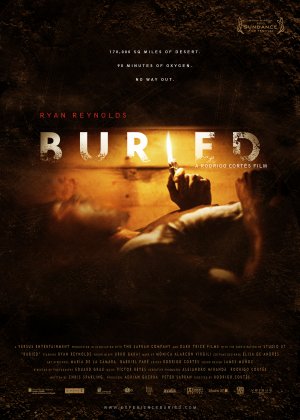
Fanboy Comics Review: Buried
Written by: Sam Rhodes, Special to CC2K
 Fanboy Comics Creative Director Sam Rhodes reviews Buried.
Fanboy Comics Creative Director Sam Rhodes reviews Buried.
Buried, written by Chris Sparling and directed/edited by Rodrigo Cortez, was an ambitious and amazing concept of a film. It follows “Paul Conroy” (Ryan Reynolds), an American truck driver working for a private company in Iraq, who was buried alive in a coffin-sized box. We start the film in the box with “Conroy,” and we never leave it for the duration of the film. He initially finds a lighter and an Iraqi cell phone, which provide most of the light for the film, as well as advancing the plot as “Conroy” receives calls from his kidnappers and dials various people back in America, including his wife, 911 operators, and the company for which he works. As he frantically tries to get someone who can help him, he is repeatedly confronted with answering machines, unfriendly officials, and muzak (as he is put on hold), from which we enjoy some of the only humor in the film. So, although we hear other actors talk to “Conroy” over the phone, Reynolds commands the screen the entire time. It sounded to me like an amazing concept and an incredibly risky endeavor; sadly, it failed.
Due mostly to the poor writing, this film flailed from contrivance to contrivance. Reynolds’ performance was strong, and there were certainly some tense moments in the film, but it was all overshadowed by the fact that most of the people he was communicating with were ludicrously unhelpful. The 911 operator claimed to be unable to do anything for the guy who is buried alive, and, when he became frustrated, told him “there’s no reason to be rude.” Could they really not help him? Was there no supervisor to call? No agency to contact? Eventually, he does get through to the FBI and to an organization in Iraq that claims to be interested in helping him, but it is as transparent to Reynolds’ character as it is to the audience that they will do nothing. “Paul Conroy” even gets through to his wife’s sister, who clearly does not care for him, but she seems more interested in arguing than in finding out why “Conroy is upset,” even after he tells her that his life is in danger. Over and over, Reynolds (in a panic) fails to explain to people his situation or is greeted with apathy. The practical lighting was an interesting aspect to the film and presented many obstacles that the filmmakers deftly overcame, but when the kidnappers direct “Conroy” to a bag that he had over looked (in his coffin-sized box) and he begins to unload light source after light source, it was as if I was watching the thought process of the writer: “Let’s give him a temperamental flashlight. Let’s give him a glow-stick.” The last complaint I’ll mention (among a sea of complaints) is the inconsistency of his box. In some shots, he could hardly move and in others he was able to turn himself around. This film aimed high and fell way short.
It’s unfortunate, because I really wanted this to be good. The film did succeed on some levels. The camera work was stylized and really illustrated the loneliness and the isolation of “Conroy,” sometimes pulling slowly out and leaving him small and meagerly lit in the center of the screen. The pacing was excellent, breaking the film up into three acts, and, although I did not stay fully invested in the story, I certainly was never bored. Reynolds was convincing for the most part and kept our attention, but too often I questioned his motivations and his reactions to the people he called. Anyway, bottom line: don’t see this movie, unless you’re a filmmaker and want to see a few shiny objects amongst a mass of well intentioned and ambitious garbage.
Sam Rhodes is the Creative Director of Fanboy Comics, an independent comic book publishing company based in Los Angeles, Calif. For more interviews, blogs, and reviews by Sam and the FBC staff, check out the Fanboy Comics website at FanboyComics.net or sign up for the e-newsletter, The Fanboy Scoop, by emailing subscribe@fanboycomics.net.
